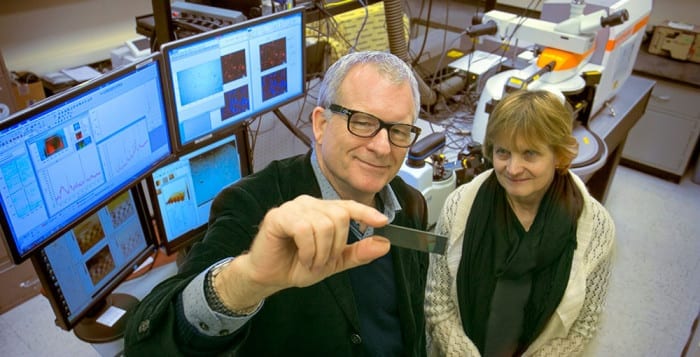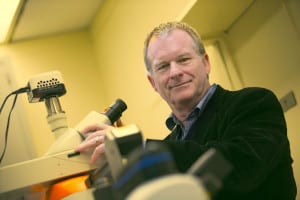SBU’s Gordon Taylor explores the world of water droplets

It’s enough to make Dr. Seuss’ Horton the Elephant and the Whos — those brave little folks we would not want to lose — proud.
Gordon Taylor, a professor of Oceanography at Stony Brook University’s School of Marine and Atmospheric Sciences, is taking a spectacularly close look at the micro community of organisms that live, eat, process elements like nitrogen, carbon, oxygen and sulfur, in droplets of ocean water.
In a milliliter of water, there are about a million bacteria, ten million viruses and about 10,000 protozoa, Taylor said. “Their cosmos is pretty much in a droplet of water.” Small though they may be, however, they are “ubiquitous,” with the ocean harboring millions of species or microorganisms.
Taylor is studying something he calls the “marine microbial community” whose composition, activity and ecosystem services vary in space and time. Understanding these communities can help oceanographers get a better grasp on the way these network of creatures affect ocean health, climate, pollution and disease in marine life.
Taylor is exploring the microbial food web in which prey items are creatures like bacteria and single-celled algae and predators are single-celled organisms that are the cousins of paramecium, amoeba and euglena.
These creatures also live with the “proverbial monkey wrench of viruses, which are also a part of this microbial food web. Every known form of life has at least one type of virus that has co-evolved to attack it,” Taylor suggested. Many organisms have multiple viral pathogens that challenge their health. On average, viruses outnumber bacteria by a factor of 10.
Colleagues at Stony Brook suggested that an appreciation for these microbial communities has broader implications.

“Understanding how microorganisms catalyze the cycling of nutrients and their responses to environmental change provides information for predictive models which are useful for informing future policy and management decisions,” explained Josephine Aller, a professor in the SoMAS. “Sometimes this information can help to alter conditions which have caused change and reverse ecological damage.”
The development of technology that can account for and interpret life at these smaller scales has enabled scientists of all kinds to ask a range of new questions about increasingly small parts of life. Physicists, for example, long ago went well past exploring protons, electrons and neutrons, and are studying quarks, gluons and other subatomic particles.
To study the marine microenvironment, Taylor will use confocal Raman microspectrometry and atomic force microscopy at the NAno-RAMAN Molecular Imaging Laboratory. A National Science Foundation Major Research Instrumentation program grant and matching support from Stony Brook helped establish the lab.
In Raman spectroscopy, researchers shine a laser light through a lens onto the specimen. This technology is used to grade commercial diamonds. When the laser light, which is a single wavelength, hits the specimen, most of the photons are absorbed or scattered at the same wavelength. In about one in a million cases, however, the light loses energy to a molecular bond, with potentially covalently bound elements of all sorts causing Raman scattered photons. The spectra produced are a fingerprint of molecular bonds.
Taylor has coupled this spectroscopic instrument with an atomic force microscope, which can look at the surface topography and structure of small creatures. “I believe that we are the only marine/atmospheric/environmental science program in the U.S. with such a system,” he said.
Even with the technology, the two and three dimensional imaging of what’s happening remains a significant challenge, Taylor said. To explore this, he will flash-freeze seawater containing microbial communities, organic particles, gels and minerals to examine spatial relationships of organisms and processes from as close to their perspective as possible, he said.
He will also conduct tracer experiments where he adds heavy isotopes of elements like carbon and monitors how organisms react. Taylor will start by proving that he can see the organisms and the way the miniature ecosystem works.
The late Carl Sagan, narrator and co-writer of the TV series “Cosmos: A Personal Voyage,” “wondered at the cosmos,” Taylor said. “We are enthralled by the microcosmos.”
Once Taylor can define the ecosystem, he can explore how changes in temperature, pH and other environmental conditions affect life in the water droplets.
He said the structure within this small community is like a spider web. Protein strands and gels give structure to the water. Biologists are becoming increasingly interested in the ecology of small creatures that interact in these spaces, creating micro-communities that, when multiplied exponentially across the ocean, affect the global climate and its ability to react to changes in carbon dioxide or increases in temperature.
Taylor lives in East Setauket with his wife Janice, their Rhodesian ridgeback dog Luca who is five and weighs 111 pounds, and an eight-pound Boston Terrier named Iggy Pup. The Taylors’ daughter Olivia lives in lower Manhattan and will start a master of fine arts program in the fall.
As for his work, Taylor said understanding small scales in biology is critically important. “We can’t fully understand epidemiology within populations, human diseases, immune responses or therapies without comprehending processes at the molecular level,” he said.
Or, as Dr. Seuss might say, a microorganism is an organism, no matter how small.






